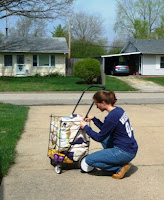Apologies for cross-posting! This is the official blog announcement.
I am pleased to announce that the book I co-authored with a neuroscience professor, neuroscience graduate student, and anthropology graduate student here on campus has just been released by MIT Press.
Individual and Collective Memory Consolidation: Analogous Processes on Different Levels is an interdisciplinary monograph that offers a unified theory of memory formation.
Here is the blurb from Amazon: We form individual memories by a process known as consolidation: the conversion of immediate and fleeting bits of information into a stable and accessible representation of facts and events. These memories provide a version of the past that helps us navigate the present and is critical to individual identity. In this book, Thomas Anastasio, Kristen Ann Ehrenberger, Patrick Watson, and Wenyi Zhang propose that social groups form collective memories by analogous processes. Using facts and insights from neuroscience, psychology, anthropology, and history, they describe a single process of consolidation with analogous--not merely comparable--manifestations on any level, whether brain, family, or society. They propose a three-in-one model of memory consolidation, composed of a buffer, a relator, and a generalizer, all within the consolidating entity, that can explain memory consolidation phenomena on individual and collective levels. When consolidation is disrupted by traumatic injury to a brain structure known as the hippocampus, memories in the process of being consolidated are lost. In individuals, this is known as retrograde amnesia. The authors hypothesize a "social hippocampus" and argue that disruption at the collective level can result in collective retrograde amnesia. They offer the Chinese Cultural Revolution (1966--1976) as an example of trauma to the social hippocampus and present evidence for the loss of recent collective memory in mainland Chinese populations that experienced the Cultural Revolution. It is available in
hardback and
Kindle formats.
The book is the product of a research assistantship I got my third year of graduate school. We figured we would work for a year or two and write a couple of articles for a neuroscience journal. As the project ballooned over the first year, we thought bigger. Pat Watson and I researched and wrote the first two thirds of the book, under the direction of Tom Anastasio (and Lillian Hoddeson). When we discovered that GoogleDocs wouldn't let us simultaneously edit separate documents, we started to sit down together at a single computer to write. Pat is a great interdisciplinary collaborator, because he knows what he knows really well, and he respects what I know. He was able to synthesize our findings, and I found the words to say it. Working with him was the best part of the whole experience. The second year, Wenyi Zhang researched and wrote about religion and literature among Chinese on the mainland and refugees to northern Thailand and Taiwan, and I helped smooth the writing of the last third to match the rest of the book. The research is mostly based on published secondary literature, plus some computer modeling from Tom and Pat. And Tom did a bang-up job getting us contract offers from both MIT Press
and Oxford University Press.
The book is really handsome, with white pages and wide margins. I love the verve of the black-red-white color scheme. And the cover really draws you in. Who is the man in the white tank top? What is his relationship as an individual to the crowd (the collective) around him? Plus, all the shades of gray suggests that memory is not something that can be restricted to black-and-white terms.
This project doesn't really have anything to do with my dissertation research, but it has shown me (again) that I can write on a large scale. (My undergraduate history honors thesis was 5 chapters and 125 pages long, and I researched and wrote it in one year!) In fact, that first dissertation chapter I am writing has now been split and one case study spun off into a whole new chapter. If that continues to happen, I will probably stop at five or six chapters and let the others become articles. Because, as they say, the best dissertation is a done dissertation. It need not include alllll the research and writing I have ever done or have yet to do on the subject. And I'm okay with that. I do hope that
Individual and Collective Memory Consolidation is just my first book of at least two, as I would love to present to you my dissertation, the published book edition.
 The last post with this title was about holiday-themed fun with food coloring; this one concerns another kind of green: environmentalism. When we bought our house a couple of years ago, Dear Husband and I decided to try to reduce our carbon footprint. I built a compost heap behind the shed in the back yard for food scraps (egg shells, carrot peelings, apple cores...). We turn off our Christmas lights when we go to bed. I wash our laundry on "tap cold" and hang almost everything to dry on lines in the back yard in the summer and on drying racks in my study during the winter. We even hand wash dishes instead using the dishwasher (mostly!).
The last post with this title was about holiday-themed fun with food coloring; this one concerns another kind of green: environmentalism. When we bought our house a couple of years ago, Dear Husband and I decided to try to reduce our carbon footprint. I built a compost heap behind the shed in the back yard for food scraps (egg shells, carrot peelings, apple cores...). We turn off our Christmas lights when we go to bed. I wash our laundry on "tap cold" and hang almost everything to dry on lines in the back yard in the summer and on drying racks in my study during the winter. We even hand wash dishes instead using the dishwasher (mostly!).











